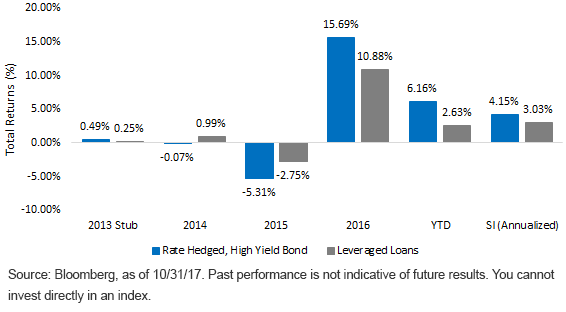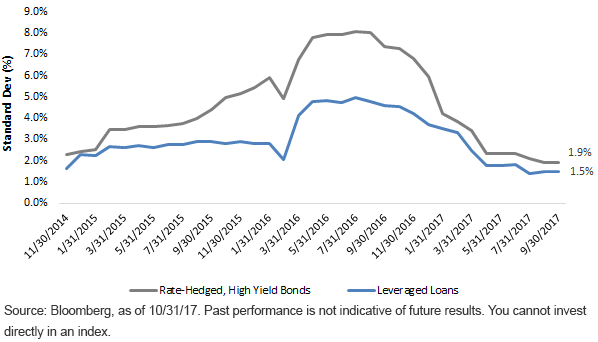Why We Favor Rate-Hedged, High-Yield Bonds Over Senior Loans


In 2013, WisdomTree created a suite of strategies that we believed could improve on traditional approaches for managing interest rate risk in bond portfolios. In our view, a potentially more intuitive alternative to senior loan strategies was to own a broad-based portfolio of high-yield bonds but then hedge out nominal interest rate risk. The resulting portfolio would have similar income, risk and total return characteristics but would still be invested in cash bonds. Since that time, the exchange-traded fund industry has seen cumulative inflows of nearly $11 billion into senior loan strategies compared to $350 million into rate-hedged, high-yield bonds.1 Despite this massive flow discrepancy, performance for loans has generally lagged. Below, we highlight the performance characteristics of the two approaches and discuss possible trade-offs going forward.
High-Income, Low-Rate Risk
For both strategies, the combination of low interest rate risk and high-income potential has seen heightened interest in the current environment. Concerns about a normalization in Federal Reserve (Fed) policy combined with an uptick in global economic momentum has seen nominal rates rise while credit spreads have tightened. Although rates have spent much of 2017 lower at tenors of greater than five years, we believe that rates could rise through the end of the year. Similarly, we do not currently forecast a meaningful uptick in the default rate. The result has credit spreads near some of their tightest levels of the cycle.
As we highlighted in a previous post, while many investors are focused on the impact that tax reform may have on U.S. corporate earnings, there may also be an equally strong positive impact on credit. If riskier borrowers pose less risk to lenders, than we believe credit spreads could continue to tighten over the next 12 to 24 months. Although a common argument by investors is that they prefer their senior position in the capital structure relative to other creditors, the fact remains that most firms that finance themselves in the loan market tend to have fairly low levels of term debt. Therefore, loan investors are often only senior to equity holders, not bondholders.
Performance Differential
In the chart below, we show the performance of rate-hedged, high-yield bonds2 versus leveraged loans.3 Since the Fed began tapering in December 2013, rate-hedged, high-yield bonds have outperformed loans by over 100 basis points (bps) per year. Over that same period, high-yield bonds have outperformed on a fairly consistent basis (four out of six calendar years). The most notable exception to this rule was in 2015. This significant period of underperformance was primarily a function of a marked decline in oil prices. While energy companies make up approximately 16% of the investable universe of high-yield debt, they represent an exceedingly small amount of the loan market (which tends to have a greater share of technology-focused issuers). As this sector drastically underperformed other risky assets, performance of the high-yield market decoupled from loans. However, after oil prices started to stabilize in early 2016, high-yield energy bond prices recovered, dramatically outperforming all other sectors.
Annual Performance, 12/18/13–9/30/2017

In addition to the drawdown in performance, the sell-off in high-yield energy credit also had a significant impact on the volatility of the asset class. Historically, loans and hedged high-yield bonds have tended to have a comparable volatility profile. This makes sense given their comparable drivers of return. Because a major sector of the bond market was experiencing significant pressure and the rising risks of downgrades, volatility spiked to near 8% compared to 4% in the loan market. In our view, unless energy prices were to decline back to the lows seen in early 2016, we do not currently envisage a repeat of this decline in risk-adjusted performance. Going forward, we believe investors should take advantage of meaningful income advantage offered by the bond market (5.5% versus 4.6%) while still maintaining a low degree of interest rate risk.
12-Month Volatility, 12/18/13–9/30/2017

Conclusion
While far from risk-free, we believe the current balance of risks currently favors allocations to rate-hedged, high-yield bonds over loans. After significant flows to the loan market, borrowers appear to have the upper hand because of declines in covenant quality and other investor protections. Should our outlook for an acceleration economic growth occur, we believe the likely consequence will be higher nominal rates and tighter credit spreads combined with subdued levels of overall volatility.
1Source: Bloomberg, as of 10/31/17.
2As proxied by the BofA Merrill Lynch 0-5 Year US High Yield Constrained, Zero Duration Index.
3As proxied by the S&P/LSTA U.S. Leveraged Loan 100 Index.


